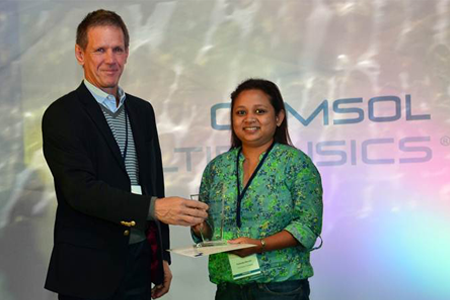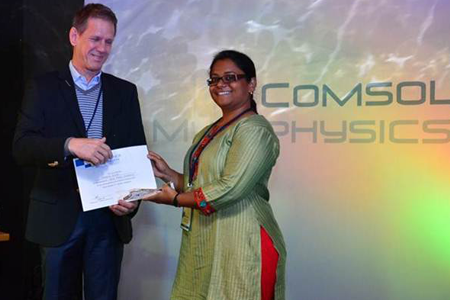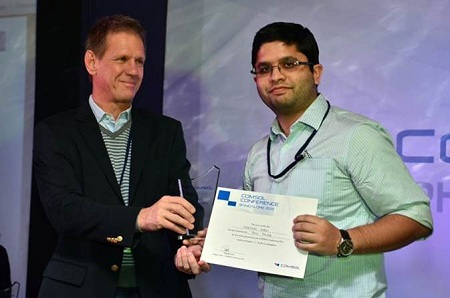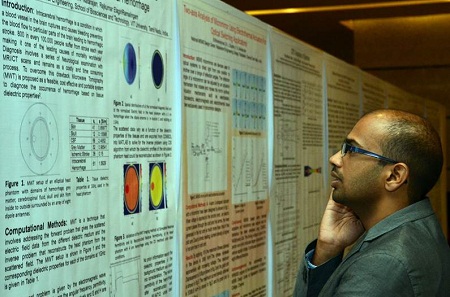
After having excellent poster and oral presentation sessions at the COMSOL Conference 2013 Bangalore, winners for the top papers and posters were announced during the award ceremony. Selecting the best ones was indeed the toughest decision that the Program Committee had to make. It was observed that the presenters had conducted rigorous analyses using COMSOL Multiphysics, and many of them also had experimental validation for their work. Now I would like to congratulate the winners once more, and allow you to appreciate the details of their research.
Congratulations to the Award Winners of the COMSOL Conference 2013 Bangalore
To celebrate some of the outstanding work, we gave out awards in four different categories at the multiphysics conference in Bangalore. The Best Paper award was given out in two subcategories: General and Academic. During the Poster Session, the panel of judges evaluated the posters and selected the winner of the Best Poster award. The fourth and final category was the Popular Choice award, where attendees voted for their favorite poster. It’s always great to get an idea of how COMSOL users view the work presented by their peers.
Best Paper Awards
The Best Paper award in the General category went to Fahmida Naznin from TVS Motors, Tamil Nadu. Fahmida presented her work on “Fast Charging Methods for Lithium Based Batteries“. She proposed an algorithm that takes into account the varying internal impedance of a battery at different state of charge (SOC) levels and minimizes voltage fluctuations. Results validation was done for the experimental and modeling outcomes, which were compared with other state-of-the art fast-charging methods available in scientific literature. As she states in her paper, “the SOC based charging method proposed in this work not only reduces the charging time drastically but also provides optimum battery performance and better thermal management due to controlled charging.”

Fahmida Naznin of TVS Motors, Tamil Nadu.
In the Academic category, the Best Paper winner Satrupa Biswas from IIT Kharagpur presented her work in the bioscience and bioengineering application area. She carried out her work on the optimization of an electrode geometry in an epiretinal prosthesis. As Satrupa discusses in her paper, when photoreceptors are damaged, which causes blindness, the surviving inner retinal neurons and retinal ganglion cells (RGC) can be electrically stimulated to restore vision. In this paper, the electrode-tissue interface was modeled to study the effect of electrode size and the distance between the electrode and retina. A biphasic pulse train signal was applied for the electrode stimulation, which is very similar to the stimulation signals given in the actual clinical trials. Inhomogeneous tissues were depicted by incorporating the appropriate material profiles. This study provides more insight into the electric field distribution across the tissue layer. Additionally, impedance measurement across the layers gives more information about proper positioning of the electrodes during implantation.

Satrupa Biswas of IIT Kharagpur.
Electromagnetics Simulations Feature Prominently in the Poster Submissions
Harshad Surdi from Tata Institute of Fundamental Research (TIFR) won the Best Poster award for his work on “Enhancement of Terahertz Emission by AuGe Nanopatterns“. In order to increase the emission efficiency of a terahertz (THz) Photo-Conductive Antenna (PCA), Harshad demonstrated the structure of a PCA with gold germanium (AuGe) nano-patterns. As observed in the simulation results, he saw the same trend of an approximately four-fold increase in the THz emission power with fabricated devices as well.

Harshad Surdi of Tata Institute of Fundamental Research (TIFR).
The poster “Computational design and analysis of Microwave Tomography in Intracerebral Hemorrhage” was the most popular poster among the conference attendees. For this work, Priyadarshini Natarajan from VIT Tamil Nadu won the Popular Choice vote for Best Poster. She discussed the microwave tomography method wherein tissue dielectric properties were used detect the hemorrhage.

It was a pleasure to review such wonderful submissions for the COMSOL Conference 2013 Bangalore. All the presentations were definitely worthy of appreciation and recognition. Congratulations to this year’s winners!




Comments (0)